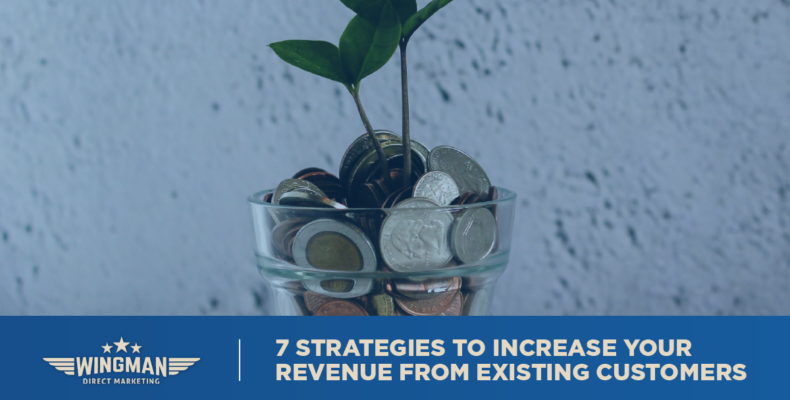Your past customers are a huge asset to your business, especially in times like this when leads may be harder to come by. It’s exceedingly important to maintain a strong relationship with your past and existing clients so they stay loyal to your business. Yet, many small businesses spend most of their marketing dollars on finding new customers instead of nurturing the ones they already have to increase their revenue.
Acquiring new customers can be expensive and time-consuming. In fact, research shows that attracting new customers is up to 5X more expensive than keeping your existing customers. You can increase revenue from existing customers by fostering relationships with the individuals and businesses that buy from you. To market to your existing customer base, try these seven tips.
1. Conduct Market Research
Conducting market research and analytics about your existing customers can open doors to new opportunities. Some tactics for increasing your knowledge of your customers can come from a variety of source including:
- Market analysis
- Surveys, focus groups, and interviews
- Use of social listening to monitor what customers say
- Customer journeys through your website also segmented by demographic and geographic variables
- Keywords driving the most traffic as well as your position in search for these keywords
Studying your market helps you dissect your existing customers’ thought processes, their common pathways (journeys) leading to purchase, snags in the customer journey, and even identifying unmet needs that reflect opportunities for you to stand out from the competition.
2. Determine what kind of customers you DON’T want
As in #1, conducting market research can also shine a light on whom you don’t want. Customers you don’t want could include:
- Customers who purchase small quantities yet require premium pricing and/ or service.
- Buyers who are demanding and never satisfied regardless of the quality of your products and services
In the first case, you have options to increase revenue from these customers by tying your pricing to the revenue generated by these customers. Commonly, businesses offer free shipping but only when sales volume exceeds a certain threshold. The higher sale value offsets the cost incurred in shipping products. You might similarly charge a lower price for buyers who purchase from you frequently.
Getting rid of customers in the second category is much harder. A solution for these customers is to discourage purchases in the first place. For instance, remove them from your marketing automation system so they don’t get emails encouraging them to make a purchase.
3. Be Present
Once you complete the initial sale, it’s important to stay in contact to build mutually beneficial relationships. With existing customers, follow up frequently by providing something of value, not just asking for a new purchase. Marketing to current customers should be done with low-pressure conversations. You’ve already convinced the customer to buy from your business. Now, you just need to continue the dialogue. You have customer contact information collected at the point of sale. Use tools like email, phone calls, and shoutouts on social platforms to provide something of value in each message. For example:
- Keep customers in the loop through phone calls, email marketing or direct mail about things happening at your business. Customers love this peek behind the scenes.
- Share company-related news through storytelling, such as the story behind a new hire, philanthropic efforts by the brand, or its employees.
- Celebrate a customer who did something remarkable even if their actions were unrelated to your brand.
4. Update Your Offerings
As your business grows, your offerings change. Turn to existing customers when it comes to deciding what offerings to eliminate and where opportunities exist. Communicate your offerings regularly.
5. Upsell and Cross-sell
Existing customers offer great opportunities for upsells and cross-sells. You’ve already gotten over the biggest hurdle, which is the initial buy. You’ve established trust and started a relationship, and the customer formed a favorable opinion about your business. Now, it’s time to ask, “What else can I do for you?” An upsell happens when you convince a customer to buy more than they originally planned. Cross-selling is like an upsell. Instead of the same kind of item with a higher value, the customer buys a different product or service. Upsells and cross-sells are extremely valuable when marketing to existing customers. Usually, the more a customer spends at a business, the more often they return.
6. Refer a Friend
Your customers are your best brand advocates. But you don’t want to leave this valuable marketing tactic to chance. You can create a process for your customers to invite their friends and family to try your products and services by:
- Proactively encouraging positive posts from your customers by requesting reviews
- Asking customers to share their purchases by including simple buttons that share their purchase across their social platforms.
- Encourage engagement by turning your social media into 2-way communication
- Reward customers who share your content with a tip of the hat or some other reward.
- Host contests on your social platforms that encourage customers to share pictures of them using your products.
7. Create a Loyalty Program
Selling to existing customers becomes easier when customers feel appreciated. By offering a reward for choosing your business, you gain more repeat customers. A loyalty program rewards customers for buying from your business again and again. Set up a loyalty program for your business to encourage customers to keep coming back. A loyalty program pulls customers back to your company, increasing your bottom line in business.
Conclusion
The above seven insights have only scratched the surface of ways to increase revenue from your existing customers. Need a hand? Wingman Direct Marketing knows how to get your message to your existing customers and keep them interested. Book a Wingman today. You don’t have to fly solo.

